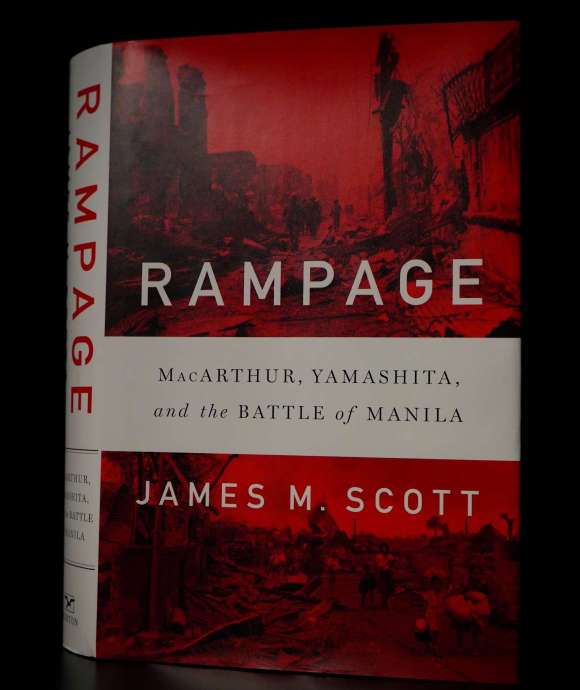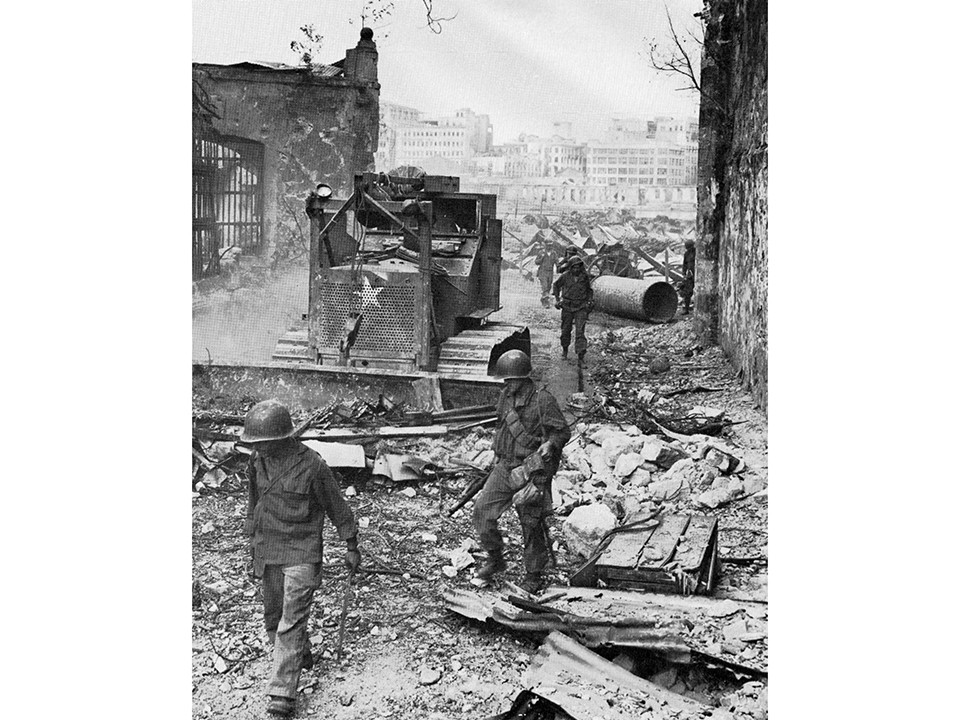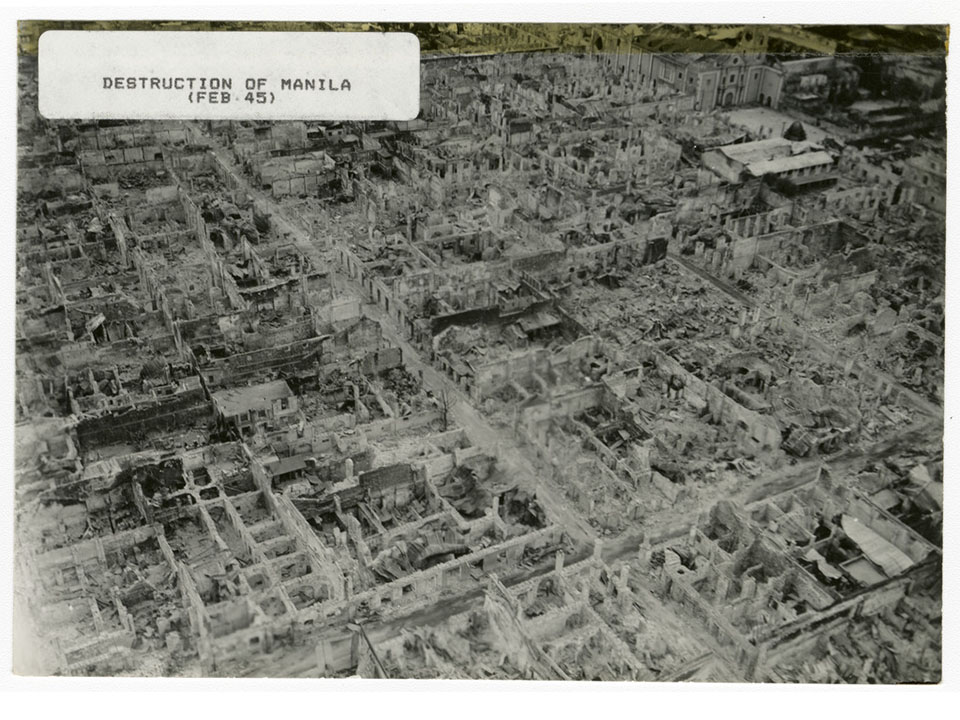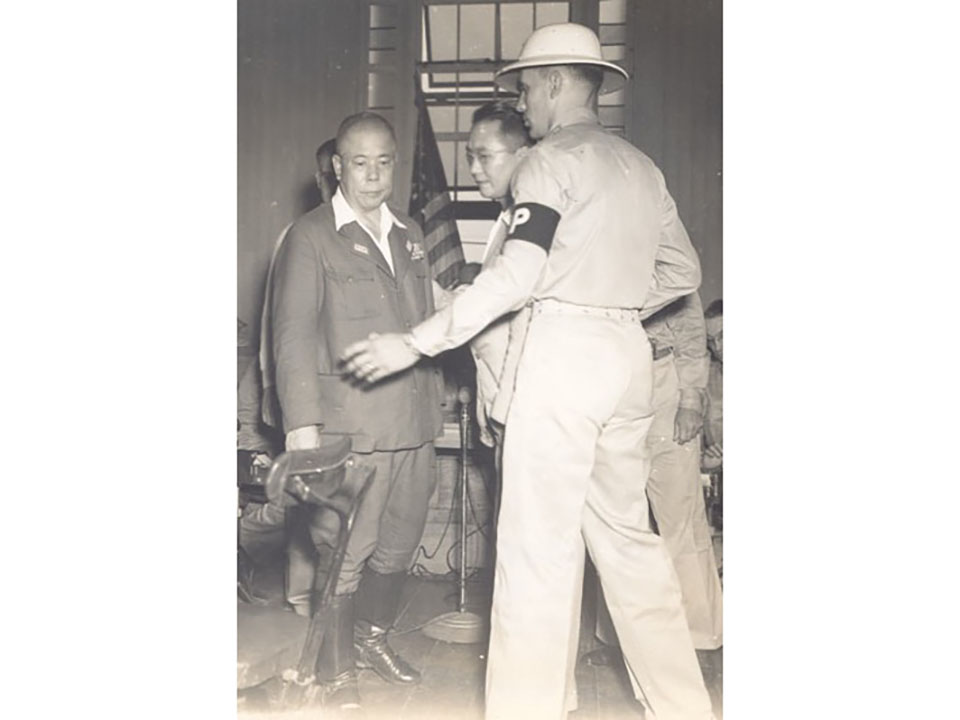On February 3, 1945, the Battle of Manila began when the American forces attacked the Japanese, who had occupied the Philippines and its capital city for nearly three years. The month-long battle wrought devastation and unfathomable suffering on the civilians and structures of this once glorious city. It was a unique experience for the Americans fighting in the Pacific as it was the first, and only, encounter with urban warfare in that theater of operations.
To shed more light on this tragic victory, I asked author, historian, and Museum friend, James M. Scott, a few questions on the battle as he has covered this best, and most recently in his book Rampage: MacArthur, Yamashita, and the Battle of Manila.
A former Nieman Fellow at Harvard, James is the author of Rampage, which was named one of the Best Books of 2018 by the editors at Amazon, Kirkus, and Military Times, and was chosen as a finalist for the prestigious Gilder Lehrman Prize for Military History by the New York Historical Society. His other works include Target Tokyo, a 2016 Pulitzer Prize finalist, The War Below, and The Attack on the Liberty, which won the Rear Admiral Samuel Eliot Morison Award. Scott lives with his wife and two children in Mount Pleasant, South Carolina.
Q: In order to appreciate what was lost during the Battle of Manila, it’s important to know what made the city earn its pre-war nickname as “the Pearl of the Orient.” Tell us about Manila before December 1941.
A: America captured the Philippines during the Spanish-American War, ultimately working to reshape the capital in our image. To spearhead that transformation, the United States hired famed municipal planner and architect Daniel Burnham, who over the years helped cities like Chicago and San Francisco. He oversaw the redo of the National Mall, and designed Washington’s landmark Union Station and New York’s iconic Flatiron Building. Burnham saw incredible potential in Manila with its vast natural resources, centuries-old Spanish Churches, and the ancient walled city of Intramuros—the 160-acre historic heart of Manila, built soon after the city’s founding in 1571.
In the four decades leading up to World War II, Manila developed into a small slice of America in Asia, home not only to thousands of US service members, but employees of companies like General Electric, Del Monte, and B.F. Goodrich. The city boasted a great quality of life, with department stores and social clubs, golf courses and swimming pools, all in a tropical setting, and at a fraction of the cost of living in the United States.
CBS News correspondent Bill Dunn summed it up best: “The Manila of 1941 was a unique Manila, a Manila that had never existed before, a Manila that would never exist again.”
Q: James, much like your book on the Doolittle Raid “Target Tokyo,” you are able to bring the perspectives of those on the ground, specifically the local civilian populations, into the mix of what is a traditionally told military history. Why is that?
A: The Battle of Manila is, at its heart, a civilian story. One-hundred Filipinos died for every one US soldier, so it literally was a battle borne on the backs of the men, women, and children of Manila, many of whom suffered incredible cruelty at the hands of the Japanese. That’s why I chose to center a lot of the story around the struggle of the civilians.
Also, it’s important to remember that this battle forever wrecked the Pearl of the Orient. More than 11,000 buildings were leveled, along with countless cultural artifacts, from historical archives and paintings to priceless statues and literary works. The battle robbed Manila not only its past, but also its future, destroying much of the nation’s precious human capital; the doctors and lawyers, the educators and inventors, the moms and dads.
The 29-day fight left a deep multi-generational wound that is still raw even today, 75 years later.
Q: General MacArthur, under orders from President Roosevelt, evacuated the Philippines in March 1942. Though your book is primarily on the February 1945 battle, did you come across any journal or diary entries as to how the Filipinos felt about the collapse of the US Army in the Philippines, and on MacArthur’s “abandoning” the islands to the Japanese?
A: It wasn’t MacArthur’s departure in March that proved the biggest shock to the Filipinos. Rather, that blow came two months later after the surrender of Corregidor in May. The Japanese, in an effort to demonstrate that MacArthur’s forces were vanquished, marched thousands of American and Filipino prisoners of war through the streets of Manila. This macabre parade on May 24, 1942, which was witnessed in absolute silence by thousands of Filipinos, literally stunned the populace.
“Filipinos stood and watched in an agony of embarrassment. These were the God blessed Americans, the supposedly invincible,” recalled Philippine Journalist Nick Joaquin. “Now here they were: mighty giants being herded rudely by little Jap soldiers. We would never recover from that loss of innocence.”
Q: The three-year Japanese occupation of Manila was a brutal time. Can you give us a sense of what that period was like?
A: The Japanese looted food supplies and department stores, stole farm equipment, and left fields to rot. Imports vanished; so, too, did basic necessities like medicine. As the years passed, Manila’s economy collapsed and the social fabric began to unravel. An army of beggars flooded the streets while others resorted to thievery, including the plundering of graves in search of jewelry, dentures, eyeglasses, and even clothing; anything that could be bartered or sold to buy a fistful of rice.
Families unable to care for children went so far as to abandon them to orphanages, or even sell them. An American intelligence report in August 1944 noted that it was cheaper to buy a child than a hog in Manila. Starvation meanwhile ran rampant, claiming as many as 500 souls a day.
The thousands of American civilians, captured at the outbreak of the war, suffered equally inside internment camps, with the largest at the University of Santo Tomas. To survive, the nearly 3,700 internees ate dogs, cats, pigeons, and even rats, which fetched about eight pesos each on the camp’s black market. On the eve of the camp’s liberation in 1945, internees starved to death at a rate of three to four a day.
Q: In 1942, Manila was declared an “open city”—meaning that they would not fight against the invading Japanese forces. This was not done when the roles were reversed in 1945. What led the Japanese to make this decision, and to commit so many atrocities against the civilian population before and during the battle?
A: The Japanese later said that the decision not to declare Manila an open city came down to their inability to move supplies out of the capital before American forces arrived, which would have, in the words of Lt. Gen. Akira Muto, “make Japan a liar in the eyes of the world.”
The reality, of course, was that Japanese troops instead used the weeks prior to the cavalry’s arrival on February 3, 1945, to fortify the city in preparation for an urban siege. Troops fortified buildings, constructed, pillboxes, planted landmines, and erected tank traps.
The subsequent battle to retake Manila proved a fight unlike any other in the Pacific War, a bloody urban brawl that forced American soldiers to battle block by block, house by house, and even room by room. The end result was the catastrophic destruction of the city and a rampage by Japanese troops that claimed an estimated 100,000 lives, many slain in massacres that echoed the horror of the Rape of Nanking.
It’s important to note that captured Japanese records show that the atrocities were not random acts of violence, but instead were done under orders.
“When Filipinos are to be killed, they must be gathered into one place and disposed of with the consideration that ammunition and man power must not be used to excess,” one such order mandated. “Because the disposal of dead bodies is a troublesome task, they should be gathered into houses which are scheduled to be burned or demolished. They should also be thrown into the river.”
Q: Japanese General Yamashita was put on trial after the war and charged with violating the laws of war because he “unlawfully disregarded and failed to discharge his duty as commander to control the operations of the members of his command, permitting them to commit brutal atrocities and other high crimes against people of the United States and of its allies and dependencies, particularly the Philippines…” He was executed February 23, 1946. Was this justice served?
A: Yamashita’s trial—the haste of it, the unorthodox regulations, the allowance of hearsay testimony, etc.—still sparks controversy even today.
The Japanese general, who was not in Manila during the battle, claimed after the war that he was ignorant of the atrocities that occurred in the capital. He blamed Rear Admiral Sanji Iwabuchi, who was the commander of the Manila Naval Defense Force and who was killed in the waning days of the fight.
As the prosecution noted in the trial, however, Yamashita’s rogue commander defense failed to explain the myriad atrocities that occurred outside of Manila. In fact, of the 300 major atrocities American war crimes investigators documented in the Philippines, only 27 took place in Manila.
Furthermore, Yamashita was no stranger to this type of violence. His own troops had killed thousands of Chinese after the fall of Singapore while his chief of staff in the Philippines, Akira Muto, was later hanged in part for his role in the Rape of Nanking.
Q: Here we are in 2020, the world will be commemorating and, in some ways, celebrating the 75th anniversary of the end of the war and victory in Germany and Japan. Is the war in the Philippines remembered today with any ambivalence?
A: There is certainly a tug-of-war in the Philippines today over the legacy of this battle, and specifically who is more responsible—the Americans or the Japanese—for the destruction of the Pearl of the Orient.
The Japanese, who are one of the largest suppliers of both foreign and military aid to the Philippines, have tried over the years to shift the blame to America. While there is no doubt that American artillery played a role in some of the destruction, it certainly wasn’t all of it. In fact, Japanese troops intentionally burned the city’s financial and retail districts as well as many of the nicer residential areas.
But convincing younger generations, who don’t remember firsthand the violence of World War II, has proven a challenge and exposed a generational divide. America’s post-war meddling in Philippine affairs hasn’t helped our reputation either.
But there are groups, like the Memorare Manila 1945 Foundation, a wonderful organization of battle survivors and their descendants, who work tirelessly to organize lectures, symposiums, and essay contests to make sure the tragedy is accurately remembered.
Q: You have a beautiful family, with a wife and two kids. How did you manage the research and writing of these horrific episodes inflicted on these people, especially women and children? Did it wear on you or were you able to compartmentalize it?
A: I knew starting this project that the Battle of Manila was awful, but I didn’t grasp just how horrible it was until I waded into the thousands of pages of survivor depositions on file at the National Archives in College Park. Those statements, many of them dictated in field hospitals just weeks after the battle, provide an up close and personal view of the brutality of the Japanese, from bayoneting infants and raping women, to decapitating men by the hundreds.
What bothered me the most, as the father of two children, were the accounts of starvation and violence inflicted upon the young, who are helpless. Most afternoons when my kids came home from school I was at the backdoor to greet them with a big hug—and it was more for me than for them.
Q: Last question…what’s next for you?
A: I am working on a book about the March 9, 1945 firebombing of Tokyo, which was the single-most destructive raid of World War II. The attack by more than 300 B-29s killed more than 104,000 people, and incinerated sixteen square miles of the Japanese capital.
It also was a moral turning point for American commanders, who up until that strike, had resisted intentionally targeting civilians. The success of that mission, coupled with the lack of pushback from American politicians and the public, served as a greenlight for the ultimate destruction of more than 60 Japanese cities, and the atomic bombings of Hiroshima and Nagasaki.
So stay tuned!
For more on the Battle of Manila, and James M. Scott's "Rampage," watch his presentation at the Museum’s 2018 International Conference on World War II here.

Review of Rampage: MacArthur, Yamashita, and the Battle of Manila
James Scott’s Book Rampage Depicts One of the Bloodiest Chapters in the History of World War II
Jeremy Collins
Jeremy Collins joined The National WWII Museum in 2001 as an intern, and now oversees the institution’s public programming initiatives.
Cite this article:
MLA Citation:
APA Citation:
Chicago Style Citation:











![Max Fuchs, New York City cantor, sings as Rabbi Sydney [sic] Lefkowitz, Richmond, VA, conducts the first Jewish services from Germany.](/sites/default/files/styles/max_650x650/public/2025-10/image1.jpg)

